BRITTANY
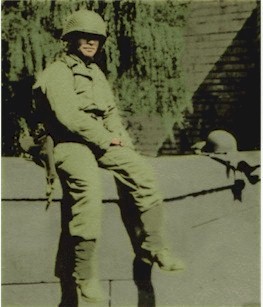 On August 1st 1944 General Omar Bradley assumed command of the newly formed 12th Army Group. General Courtney Hodges assumed command of the First Army and General George Patton assumed command of the newly formed 3rd Army. During the initial planning phases of the Normandy campaign the Allies had hoped to secure some of the channel ports in order to re-supply their Armies. However, the German destruction of the port of Cherbourg and General Montgomery’s failure to break out of the Caen area left the allies with no channel ports. Further, the Mulberry port facility at the Normandy Beach head would only be accessible for another few months until the winter weather would force the allies to shut them down. The only logical decision then was the port facilities of the Brittany peninsula. General Bradley ordered general Patton to drive west and secure the peninsula and thus the ports. Patton sent the 4th armored division towards Rennes through Quiberon and sent the 6th armored towards Brest. VIII corps under the command of General Troy S. Middleton was given the task of clearing out the remaining German forces in Brittany. The 83rd Infantry was given the task of capturing St Malo and Dinard. After the break out in Normandy the 83rd Division was located near La Cardonierre and Feugeres, and on 3-4 August they boarded trucks and started their move west into Brittany. They arrived at 1000 hours in the vicinity of Pontorson. Along the way their the GI’s encountered the French Civilians along the sides of the road cheering, waving and throwing flowers. Whenever the convoy would stop for a break, the French children would swarm over the GI’s and beg for “Chocolat”, “Bon-Bon” and “Chew Gum”. The GI’s happily complied. On the coast near Mont St. Michel, Pontorson, and Dol-de-Bretagne they received the final orders to capture the port towns of St. Malo and Dinard.
On August 1st 1944 General Omar Bradley assumed command of the newly formed 12th Army Group. General Courtney Hodges assumed command of the First Army and General George Patton assumed command of the newly formed 3rd Army. During the initial planning phases of the Normandy campaign the Allies had hoped to secure some of the channel ports in order to re-supply their Armies. However, the German destruction of the port of Cherbourg and General Montgomery’s failure to break out of the Caen area left the allies with no channel ports. Further, the Mulberry port facility at the Normandy Beach head would only be accessible for another few months until the winter weather would force the allies to shut them down. The only logical decision then was the port facilities of the Brittany peninsula. General Bradley ordered general Patton to drive west and secure the peninsula and thus the ports. Patton sent the 4th armored division towards Rennes through Quiberon and sent the 6th armored towards Brest. VIII corps under the command of General Troy S. Middleton was given the task of clearing out the remaining German forces in Brittany. The 83rd Infantry was given the task of capturing St Malo and Dinard. After the break out in Normandy the 83rd Division was located near La Cardonierre and Feugeres, and on 3-4 August they boarded trucks and started their move west into Brittany. They arrived at 1000 hours in the vicinity of Pontorson. Along the way their the GI’s encountered the French Civilians along the sides of the road cheering, waving and throwing flowers. Whenever the convoy would stop for a break, the French children would swarm over the GI’s and beg for “Chocolat”, “Bon-Bon” and “Chew Gum”. The GI’s happily complied. On the coast near Mont St. Michel, Pontorson, and Dol-de-Bretagne they received the final orders to capture the port towns of St. Malo and Dinard.
THE BATTLE FOR SAINT MALO AND DINARD
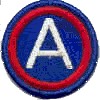 St. Malo was the main port on the northeast coast of Brittany. Because of its history as a privateer stronghold, the town was protected by thick stone walls and a fortress complex. Even though the French résistance told the Americans that as many as 10,000 troops were in the area, Army Intelligence estimated that there were only between 3,000 and 6,000 German troops. How they came upon this estimate is unclear, when actually there were more than 12,000 troops that defended the walled city and area. Later it was determined that during the chaos of the breakthrough many local garrisons escaped to St Malo as well as troops ferried in from the Channel Islands. This action swelled the numbers of troops available to defend St Malo. The port was further defended by the small island of Cezembre, with it’s long-range artillery, it could hit targets far out to sea as well as any target inland. The Garrison Commander Colonel Andreas Von Aulock vowed to "fight to the last man" even if that last man was himself. Von Aulock was a veteran of Stalingrad and he was very experienced in street fighting and defense of a city fortification. On August 5th, the French were ordered out of the town. The following morning the Germans demolished all the quays, locks, breakwaters and harbor machinery and set fire to the city. The city fortress had been heavily reinforced with concrete and contained underground tunnels, storage areas, power plants, ammo dumps, living quarters, and even a hospital. The battle was extremely difficult, and required heavy fighting to conquer these fortified German strongholds. They then fought their way through rows of steel gates, anti-tank obstacles and ditches, barbed wire, mine fields, mortar and artillery fire, and machine gun fire from pillbox positions outside the cities. In the cities of St Malo and Dinard they fought a bloody battle. Block-by-block, house-by-house, down narrow streets with snipers and machine gun nests in every house and roof top. Inside the heavily fortified city of St. Malo was the Citadel itself, defended by German troops battle wise from the Normandy campaign.
The battle for St. Malo and Dinard required
St. Malo was the main port on the northeast coast of Brittany. Because of its history as a privateer stronghold, the town was protected by thick stone walls and a fortress complex. Even though the French résistance told the Americans that as many as 10,000 troops were in the area, Army Intelligence estimated that there were only between 3,000 and 6,000 German troops. How they came upon this estimate is unclear, when actually there were more than 12,000 troops that defended the walled city and area. Later it was determined that during the chaos of the breakthrough many local garrisons escaped to St Malo as well as troops ferried in from the Channel Islands. This action swelled the numbers of troops available to defend St Malo. The port was further defended by the small island of Cezembre, with it’s long-range artillery, it could hit targets far out to sea as well as any target inland. The Garrison Commander Colonel Andreas Von Aulock vowed to "fight to the last man" even if that last man was himself. Von Aulock was a veteran of Stalingrad and he was very experienced in street fighting and defense of a city fortification. On August 5th, the French were ordered out of the town. The following morning the Germans demolished all the quays, locks, breakwaters and harbor machinery and set fire to the city. The city fortress had been heavily reinforced with concrete and contained underground tunnels, storage areas, power plants, ammo dumps, living quarters, and even a hospital. The battle was extremely difficult, and required heavy fighting to conquer these fortified German strongholds. They then fought their way through rows of steel gates, anti-tank obstacles and ditches, barbed wire, mine fields, mortar and artillery fire, and machine gun fire from pillbox positions outside the cities. In the cities of St Malo and Dinard they fought a bloody battle. Block-by-block, house-by-house, down narrow streets with snipers and machine gun nests in every house and roof top. Inside the heavily fortified city of St. Malo was the Citadel itself, defended by German troops battle wise from the Normandy campaign.
The battle for St. Malo and Dinard required 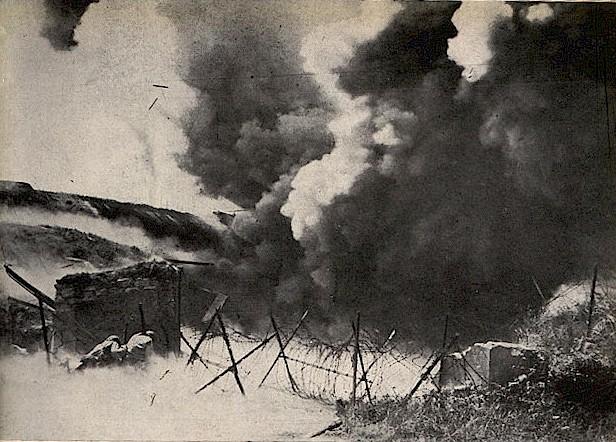 attacks on four different fronts by all three infantry regiments of the 83rd as well as the 121st Infantry Regiment of the 8th Infantry Division. The division was further supported by the tankers of the 705th TD battalion, and elements of the 308th Combat Engineers and the 86th Chemical Battalion. Artillery support consisted of the 83rd’s own artillery as well as a battalion of the VIII Corps artillery. As the French civilians were being evacuated from St. Malo the 83rd began it’s attack.
At 0830 on the Morning of the August 5th the 331st Regiment jumped off its advance with it’s 1st and 3rd battalions. The 329th and two battalions of 330th followed suit. The third battalion along with the 83rd Recon battalion was detached to Task Force “A” and was pushing west towards Dinan. The 329th’s 1st and 2nd battalions moved on Chateauneuf and encountered moderate to heavy resistance. 2nd Battalion was hard hit when two of it’s Commanders were lost in the attack. Captain Sharpe recently arrived from the hospital assumed command and pressed on the attack. After a difficult advance the 329th entered Chateuneuf only to be greeted by a heavy volume of artillery and mortar fire. Meanwhile on the right flank Uncle Rolland’s B Company of the 331st advanced along a railroad track about 6 kilometers to a set of concrete canals. As the troops began to cross the Germans opened fire with their concealed machine guns. B company withdrew to the far embankment and dug in. C company in a flanking movement
attacks on four different fronts by all three infantry regiments of the 83rd as well as the 121st Infantry Regiment of the 8th Infantry Division. The division was further supported by the tankers of the 705th TD battalion, and elements of the 308th Combat Engineers and the 86th Chemical Battalion. Artillery support consisted of the 83rd’s own artillery as well as a battalion of the VIII Corps artillery. As the French civilians were being evacuated from St. Malo the 83rd began it’s attack.
At 0830 on the Morning of the August 5th the 331st Regiment jumped off its advance with it’s 1st and 3rd battalions. The 329th and two battalions of 330th followed suit. The third battalion along with the 83rd Recon battalion was detached to Task Force “A” and was pushing west towards Dinan. The 329th’s 1st and 2nd battalions moved on Chateauneuf and encountered moderate to heavy resistance. 2nd Battalion was hard hit when two of it’s Commanders were lost in the attack. Captain Sharpe recently arrived from the hospital assumed command and pressed on the attack. After a difficult advance the 329th entered Chateuneuf only to be greeted by a heavy volume of artillery and mortar fire. Meanwhile on the right flank Uncle Rolland’s B Company of the 331st advanced along a railroad track about 6 kilometers to a set of concrete canals. As the troops began to cross the Germans opened fire with their concealed machine guns. B company withdrew to the far embankment and dug in. C company in a flanking movement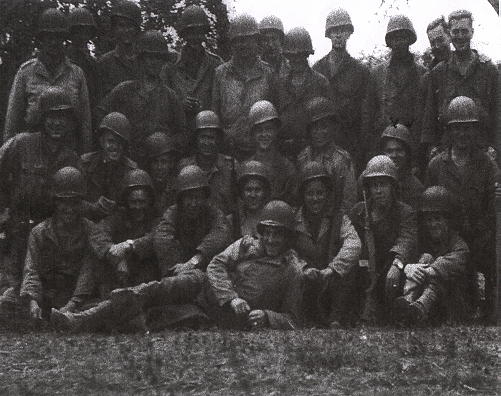 advanced on the German guns and soon silenced them. After 1st battalion achieved it’s objectives they dug in for the night. The next day on August 7th the attack resumed in force. The 121st regiment of the 9th Infantry division under the command of Colonel John R. Jeter crossed the Rance river to destroy the garrison at Dinard. Previously the 121st had taken the surrender of the garrison at Dinan. As the 121st moved north towards Dinard. The 121st quickly found out that every road north to Dinard were blocked by concrete, rock, felled trees and barbed wire, each were covered by camouflaged strong points manned with platoon sized troops with automatic weapons. Needless to say the advance of the 121st was painfully slow. On the afternoon of August 8th the 3rd battalion entered the village of Pleurtuit as the troops moved into the village several German tanks counter-attacked the flanks of the advance and cut off the battalion. For several days the battalion was surrounded and was unable to move forward or to get out of the trap. Cut off and isolated the battalion had to dig in and wait to be rescued.
On August 9th the area known as St Joseph’s hill was captured with over 400 prisoners. After the capture of St. Josephs hill the 331st was relieved by the 330th infantry and sent to a position 56 miles west from where they started on the left flank of the assault across the Rance River. Their mission was to relieve the beleaguered 3rd battalion of the 121st Infantry.
advanced on the German guns and soon silenced them. After 1st battalion achieved it’s objectives they dug in for the night. The next day on August 7th the attack resumed in force. The 121st regiment of the 9th Infantry division under the command of Colonel John R. Jeter crossed the Rance river to destroy the garrison at Dinard. Previously the 121st had taken the surrender of the garrison at Dinan. As the 121st moved north towards Dinard. The 121st quickly found out that every road north to Dinard were blocked by concrete, rock, felled trees and barbed wire, each were covered by camouflaged strong points manned with platoon sized troops with automatic weapons. Needless to say the advance of the 121st was painfully slow. On the afternoon of August 8th the 3rd battalion entered the village of Pleurtuit as the troops moved into the village several German tanks counter-attacked the flanks of the advance and cut off the battalion. For several days the battalion was surrounded and was unable to move forward or to get out of the trap. Cut off and isolated the battalion had to dig in and wait to be rescued.
On August 9th the area known as St Joseph’s hill was captured with over 400 prisoners. After the capture of St. Josephs hill the 331st was relieved by the 330th infantry and sent to a position 56 miles west from where they started on the left flank of the assault across the Rance River. Their mission was to relieve the beleaguered 3rd battalion of the 121st Infantry.
The Following is an except from the 121st’s official history: The 121st Infantry Regiment, under VIII Corps control, was attached, on August 6th, to the 83rd Infantry Division, and immediately began movement by motor to Dinard. Near Tremereuc, on the following day, it encountered determined resistance. Road blocks and heavy machine gun fire forced the Regiment to detruck and fight its way forward. Scarcely was the attack underway when the enemy showed that he was prepared to offer the most determined resistance. From concrete pillboxes, protected by formidable tank obstacles and numerous minefields and barbed wire entanglements, the Germans fought back. Enemy mortar and machine gun fire was severe, and several tanks were encountered. On August 9th, the 3rd Battalion was cut off from the Regiment. For three days it withstood almost incessant artillery bombardment and repeated attempts by the enemy to annihilate it, suffering many casualties, but throwing the enemy back every time he attacked. Two artillery liaison planes flew over the position, successfully dropping blood plasma, and then collided in mid air, destroying both
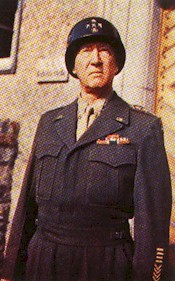 planes and killing all occupants.
At this point General Patton made a visit to General Macon and the 83rd division during
the assault to assess the situation at StMalo . When he arrived, he surprised General Macon who had a look of fright in his face. General Patton
realized that General Macon probably thought he was there to relieve him. So as Patton's staff car pulled up he shouted "Fine Work" to Macon to relieve the general of any misgivings. After receiving a brief from General Macon, Patton was overheard to have commented that they should go
together up to the front lines. To which General Macon replied that if the general wanted to go to the front lines he only needed to walk ahead about forty feet and he would "be in the German lines". Patton was reportedly was silent after that.
planes and killing all occupants.
At this point General Patton made a visit to General Macon and the 83rd division during
the assault to assess the situation at StMalo . When he arrived, he surprised General Macon who had a look of fright in his face. General Patton
realized that General Macon probably thought he was there to relieve him. So as Patton's staff car pulled up he shouted "Fine Work" to Macon to relieve the general of any misgivings. After receiving a brief from General Macon, Patton was overheard to have commented that they should go
together up to the front lines. To which General Macon replied that if the general wanted to go to the front lines he only needed to walk ahead about forty feet and he would "be in the German lines". Patton was reportedly was silent after that.
DINARD
On August 11th General Macon took personal command of the Dinard operation. The defense of Dinard was in the Capable hands of Colonel Bacherer who commanded a Kampfgruppe composed mostly of the 77th Infantry Division. Even with this capable leader however the Germans were unable to withstand the assault
from two regiments. On the evening of August 10th the 1st battalion of the 331st attacked north from of
Tremereuc. They crossed the stream and advanced 500 yards under a cover of darkness. Unable to locate the lost battalion the first battalion dug in and waited for daylight. At first light the attack resumed and continued all day. The 1st battalion encountered an enemy strongpoint of five pillboxes. Companies A and C bypassed the strongpoint while Uncle Rolland’s B company with tank support, assaulted the pillboxes. After a lengthy all day fight, B Company destroyed the five bunkers, along with a Panzerkampwagen Mark IV tank,
88mm gun, and 158 captured prisoners.
Meanwhile, the 330th on the northeast in bitter house-to-house fighting  captured
Parame, sealing off the enemy occupying the St. Ideuc-La-Varde area. At this point the capture of Dinard became
imperative to prevent enemy withdrawal toward Brest. and on August 12th 1st Battalion, 331st, with B Company in the lead broke through the German lines and connected with the isolated 3rd battalion of the 121st. Even though the Battalion was isolated for three days and the enemy
launched several counter attacks coordinated with artillery the 3rd battalion only lost 31 men KIA and 106 WIA. On 13 August the two regiments continued the attack on
Dinard. Rolland’s B Company captured the airfield a Lebourgneuf. The rest of the 331st regiment entered the streets of Dinard for a brutal house-to-house fight. After fighting all day, Colonel Batcherer along with his staff was captured. Once the Commander was captured resistance soon waivered and the 331st soon secured the town. 3338 prisoners were added to the 83rd’s tally.
captured
Parame, sealing off the enemy occupying the St. Ideuc-La-Varde area. At this point the capture of Dinard became
imperative to prevent enemy withdrawal toward Brest. and on August 12th 1st Battalion, 331st, with B Company in the lead broke through the German lines and connected with the isolated 3rd battalion of the 121st. Even though the Battalion was isolated for three days and the enemy
launched several counter attacks coordinated with artillery the 3rd battalion only lost 31 men KIA and 106 WIA. On 13 August the two regiments continued the attack on
Dinard. Rolland’s B Company captured the airfield a Lebourgneuf. The rest of the 331st regiment entered the streets of Dinard for a brutal house-to-house fight. After fighting all day, Colonel Batcherer along with his staff was captured. Once the Commander was captured resistance soon waivered and the 331st soon secured the town. 3338 prisoners were added to the 83rd’s tally.
SAINT MALO
Meanwhile, the attack toward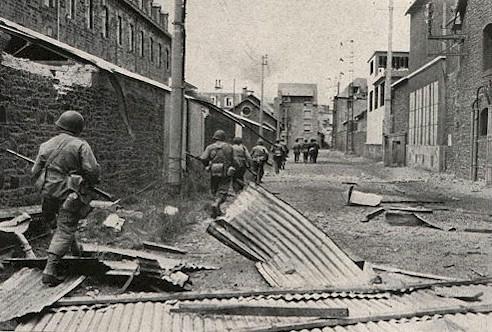 St. Malo had continued. For three days artillery pounded the entrenched German troops. Infantry and engineers assaulted the pillboxes and bunkers, some at point blank range with Anti-tank guns. The 329th advanced through the dangerous streets. Finally, after a concentrated artillery barrage and an infantry assault, 160 enemy troops surrendered. Captain Granville A. Sharpe who had just taken command of the 2nd battalion, 329th, six days earlier, redeployed his men to St. Coutombe to assault Fort de la Varde. The fort was a strongly fortified position on a small peninsula 3 miles northeast of St Malo. Captain Sharpe using his American ingenuity procured the aid of a sound truck. He issued verbal orders from the truck to his men in the field during the whole attack. When his orders were not being transmitted, he played records of victory marches. This psychological form of warfare was having it’s toll upon the hapless Germans. Upon reaching the fort Captain Sharpe’s men stormed it screaming “Indian-Style” whooping and yelling. This proved too much for the terrified Germans inside the fort, and soon they soon surrendered. The 329th then added another 197 prisoners to their total, along with vast stocks of food and equipment. The troops entered the walled town of St. Malo. Standing in their way were several blocks of houses in an area that funneled
St. Malo had continued. For three days artillery pounded the entrenched German troops. Infantry and engineers assaulted the pillboxes and bunkers, some at point blank range with Anti-tank guns. The 329th advanced through the dangerous streets. Finally, after a concentrated artillery barrage and an infantry assault, 160 enemy troops surrendered. Captain Granville A. Sharpe who had just taken command of the 2nd battalion, 329th, six days earlier, redeployed his men to St. Coutombe to assault Fort de la Varde. The fort was a strongly fortified position on a small peninsula 3 miles northeast of St Malo. Captain Sharpe using his American ingenuity procured the aid of a sound truck. He issued verbal orders from the truck to his men in the field during the whole attack. When his orders were not being transmitted, he played records of victory marches. This psychological form of warfare was having it’s toll upon the hapless Germans. Upon reaching the fort Captain Sharpe’s men stormed it screaming “Indian-Style” whooping and yelling. This proved too much for the terrified Germans inside the fort, and soon they soon surrendered. The 329th then added another 197 prisoners to their total, along with vast stocks of food and equipment. The troops entered the walled town of St. Malo. Standing in their way were several blocks of houses in an area that funneled
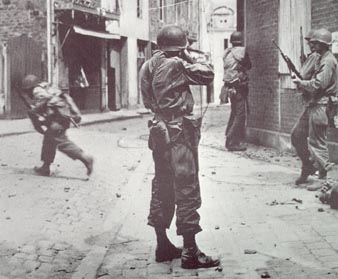 toward a narrow causeway strip. These houses had to be cleared of all enemy before they could advance. Once the houses had been cleared the men advanced past a narrow strip of land with a causeway that connected the city to the mainland. At the nearest end of the causeway was a Casino, which the Germans had set up as a defensive position. With concentrated tank and tank destroyer fire, the infantry fought for two days house to house. The engineers dynamited passageways from house to house so the infantry could fight from one building to the next. After intense fire, the Casino fell. A narrow causeway, less than 1000 yards long, leading to the Chateau of Anne of Brittany and the walled gate into the town was all that remained. But the causeway was exposed to enemy fire. A small garrison of enemy troops employed machine guns and a 20-mm AA gun, from atop the donjon. The thick walls designed to withstand medieval siege proved effective against the modern artillery of the 83rd. The guns pummeled the chateau for two days. Shells from tank destroyers, 8-inch howitzers and large 155 mm guns had little or no effect. Squadrons of medium and heavy bombers produced no apparent result. The fires within the town of St. Malo had become out of control. Flames and thick black smoke plumed from much of the city. Colonel Von Aulock realizing that their were still many French civilians within the city’s walls, arranged a cease fire to allow them to evacuate. Once the civilians fled from the town, the fighting continued. Finally, under a cover of an artillery barrage and with the limited visibility from all the smoke, the troops raced across the causeway, past the chateau, and through the gate into the town itself. Once inside the walled city, only a
toward a narrow causeway strip. These houses had to be cleared of all enemy before they could advance. Once the houses had been cleared the men advanced past a narrow strip of land with a causeway that connected the city to the mainland. At the nearest end of the causeway was a Casino, which the Germans had set up as a defensive position. With concentrated tank and tank destroyer fire, the infantry fought for two days house to house. The engineers dynamited passageways from house to house so the infantry could fight from one building to the next. After intense fire, the Casino fell. A narrow causeway, less than 1000 yards long, leading to the Chateau of Anne of Brittany and the walled gate into the town was all that remained. But the causeway was exposed to enemy fire. A small garrison of enemy troops employed machine guns and a 20-mm AA gun, from atop the donjon. The thick walls designed to withstand medieval siege proved effective against the modern artillery of the 83rd. The guns pummeled the chateau for two days. Shells from tank destroyers, 8-inch howitzers and large 155 mm guns had little or no effect. Squadrons of medium and heavy bombers produced no apparent result. The fires within the town of St. Malo had become out of control. Flames and thick black smoke plumed from much of the city. Colonel Von Aulock realizing that their were still many French civilians within the city’s walls, arranged a cease fire to allow them to evacuate. Once the civilians fled from the town, the fighting continued. Finally, under a cover of an artillery barrage and with the limited visibility from all the smoke, the troops raced across the causeway, past the chateau, and through the gate into the town itself. Once inside the walled city, only a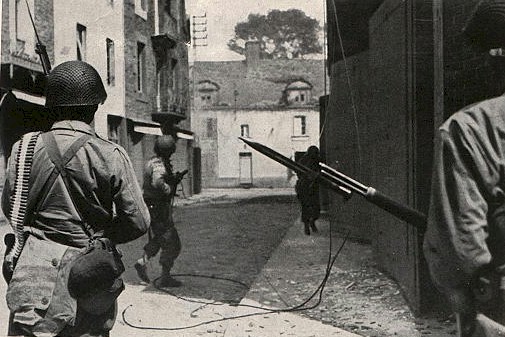 few enemy troops remained in the burned, ruined, and demolished buildings. However the defenders in the chateau still held out, and their machine guns firing murderously at the engineers attempting to place demolition charges against the walls. Only after concentrated artillery and tank fire, combined with the hopelessness of the situation prompted the Germans to surrender. Prisoners totaled 150 men. Two forts on two small islands, several hundred yard apart, were attacked by Captain Sharpe’s 2nd battalion. Fort National and Grand Bey, each comprising of several blockhouses, had to be investigated. At low tide the men crossed the sand to Fort National and found it unoccupied. Then they assaulted Grand Bey under a smoke screen," a company commander later reported, "took them by surprise, tossed a few hand grenades, and they gave up”. They captured another 150 men and more quantities of food and equipment.
few enemy troops remained in the burned, ruined, and demolished buildings. However the defenders in the chateau still held out, and their machine guns firing murderously at the engineers attempting to place demolition charges against the walls. Only after concentrated artillery and tank fire, combined with the hopelessness of the situation prompted the Germans to surrender. Prisoners totaled 150 men. Two forts on two small islands, several hundred yard apart, were attacked by Captain Sharpe’s 2nd battalion. Fort National and Grand Bey, each comprising of several blockhouses, had to be investigated. At low tide the men crossed the sand to Fort National and found it unoccupied. Then they assaulted Grand Bey under a smoke screen," a company commander later reported, "took them by surprise, tossed a few hand grenades, and they gave up”. They captured another 150 men and more quantities of food and equipment.
THE CITADEL

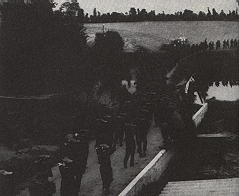 fired 3-in., 105mm, 155mm, and 8-in guns at the
fort, some at point blank range. Medium and heavy Bombers dropped tons of
ordnance on the fort . Many 500 and 1000 pound bombs along with 100 pound
incendiaries blasted the Citadel with no effect. Tank destroyers assisted by
division artillery pounded the Citadel for two straight days. Two 8 inch guns of
the Corps artillery came within 1500 yards of the fort and fired directly into
the port holes and vents. fighter bombers loaded with a new weapon "Jellied
Gasoline" (Later called Napalm) Finally, appeared out of the sky to bomb
the fort. As the fighter-bombers arrived over the target in support of a third infantry assault, Colonel Von
Aulock suddenly raised the white flag of surrender. The Fighter bombers
were quickly diverted to attack Cezembre. Von Aulock gave up along with 400 officers and men.
What caused the Commander to finally give up?
fired 3-in., 105mm, 155mm, and 8-in guns at the
fort, some at point blank range. Medium and heavy Bombers dropped tons of
ordnance on the fort . Many 500 and 1000 pound bombs along with 100 pound
incendiaries blasted the Citadel with no effect. Tank destroyers assisted by
division artillery pounded the Citadel for two straight days. Two 8 inch guns of
the Corps artillery came within 1500 yards of the fort and fired directly into
the port holes and vents. fighter bombers loaded with a new weapon "Jellied
Gasoline" (Later called Napalm) Finally, appeared out of the sky to bomb
the fort. As the fighter-bombers arrived over the target in support of a third infantry assault, Colonel Von
Aulock suddenly raised the white flag of surrender. The Fighter bombers
were quickly diverted to attack Cezembre. Von Aulock gave up along with 400 officers and men.
What caused the Commander to finally give up? 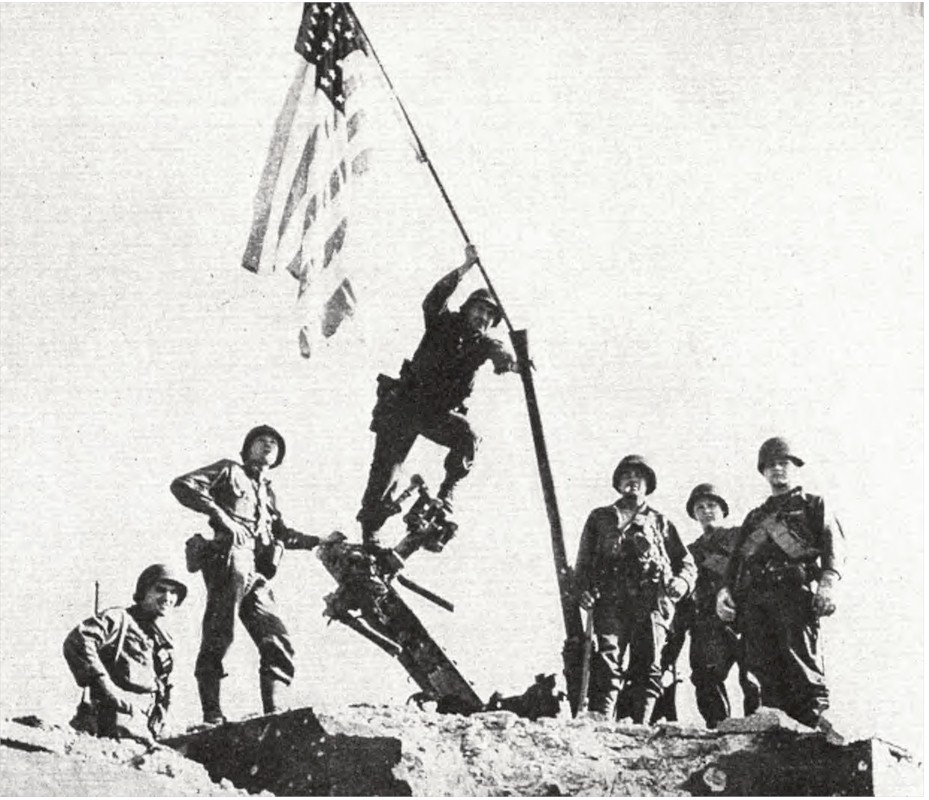
CEZEMBRE
4000 yards off shore was the
island fortress of Cezembre. Half a mile long by a quarter of a mile
wide controlled the channel to St Malo and the approaches to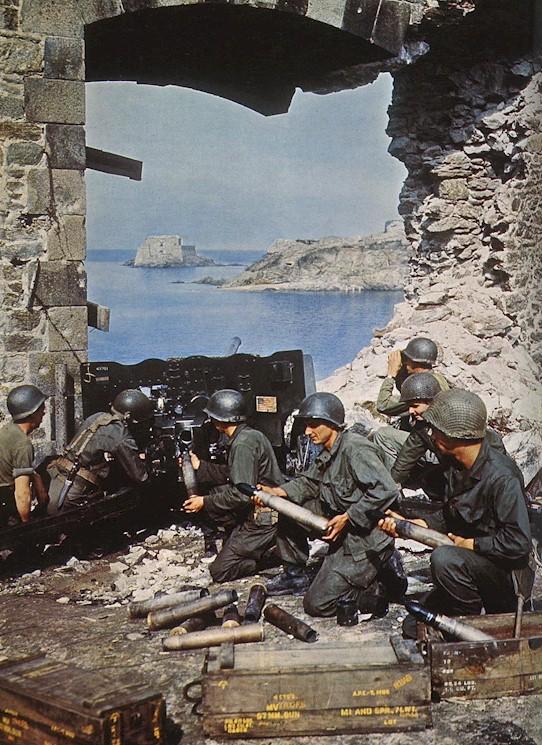 Granville and
Cancale. The thirty-five Fighter Bombers that were diverted from the
Citadel assault, dropped their napalm on the Island. Thick plumes of black smoke
rose high above the fortress. After a the attack Major General Macon ordered
Major Joseph M. Alexander and two enlisted men to row out to the fortress island
and demand the Germans surrender. After much discussion the German Commander
refused stating that he was under orders to maintain his defense and until he
received contrary orders he was to do just that. Even after he was informed of
Von Aulock's surrender the commander still refused. The men rowed back with the
news to general Macon. No further attempts to take the Island were undertaken.
It was decide to bypass the island and wait for the Germans out. However, events
on the assault on Brest would force the Americans to deal with Cezembre. The
330th regiment remained behind as the rest of the 83rd moved off to their next
mission. On 31 August 24 P-38's dropped Napalm and 300 bombers
bombed the fortress. Still the German Commander
refused to surrender. The Americans increased the pressure. On September 2nd
after a concentrated bombing effort from aircraft, and shelling from land
artillery, as well as a 15 inch shells from the battleship HMS Warspite, The
Germans finally raised the white flag of surrender. So ended the
Assault on St Malo and Dinard. but there would be more action of a different
type on the 83rd's next assignment the Loire Valley and Luxembourg.
Granville and
Cancale. The thirty-five Fighter Bombers that were diverted from the
Citadel assault, dropped their napalm on the Island. Thick plumes of black smoke
rose high above the fortress. After a the attack Major General Macon ordered
Major Joseph M. Alexander and two enlisted men to row out to the fortress island
and demand the Germans surrender. After much discussion the German Commander
refused stating that he was under orders to maintain his defense and until he
received contrary orders he was to do just that. Even after he was informed of
Von Aulock's surrender the commander still refused. The men rowed back with the
news to general Macon. No further attempts to take the Island were undertaken.
It was decide to bypass the island and wait for the Germans out. However, events
on the assault on Brest would force the Americans to deal with Cezembre. The
330th regiment remained behind as the rest of the 83rd moved off to their next
mission. On 31 August 24 P-38's dropped Napalm and 300 bombers
bombed the fortress. Still the German Commander
refused to surrender. The Americans increased the pressure. On September 2nd
after a concentrated bombing effort from aircraft, and shelling from land
artillery, as well as a 15 inch shells from the battleship HMS Warspite, The
Germans finally raised the white flag of surrender. So ended the
Assault on St Malo and Dinard. but there would be more action of a different
type on the 83rd's next assignment the Loire Valley and Luxembourg.
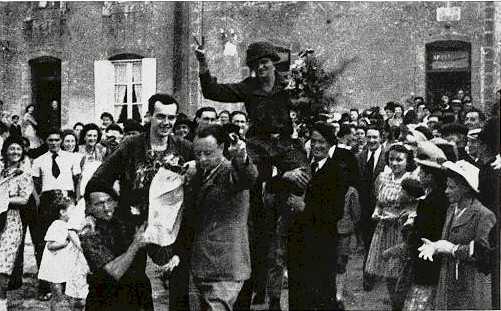 Loire Valley and Luxembourg: Guarding Patton's Flank
Loire Valley and Luxembourg: Guarding Patton's Flank
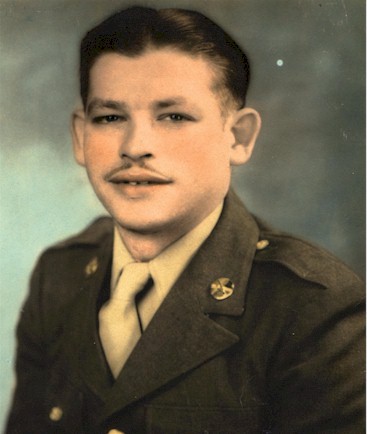 Rolland
Despres: Homepage
Rolland
Despres: Homepage They
Served with Honor: Homepage
They
Served with Honor: Homepage